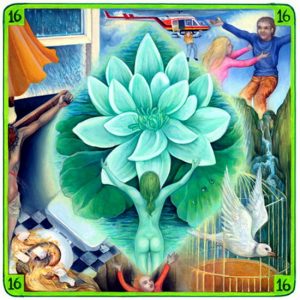The “Dreamwork Online Course in 9 Steps” is a simplified and easy-to-use version of the dreamwork psychology methodology, developed by Strephon Kaplan-Williams (1934-2009), and designed to be used by everyone interested in exploring their dreams.
Historically there has been a big tendency to impose a symbol system on dreams, to get meaning (X means Y, a car means travels, a cat means…, sex means…). In psychology movements, the symbol system is their personality theory, like the Jungian anima-animus or shadow-persona. Such imposing of a symbol system onto dreams to produce dreamwork is likely to be highly distracting, taking people away from direct re-experiencing of the dream and not towards it.
Strephon Kaplan-Williams’ major contribution was developing a comprehensive dreamwork methodology beyond any symbol systems, which, when applied to a dream series and personal development, led to personal growth and wholeness. Kaplan-Williams has also done much work in separating out ego dynamics from archetypal patterns by working with the dream ego (the image of the dreamer in the dream), to create a more active and integrative dream ego in future dreaming and to create a more effective and real waking ego, that can handle life in vastly superior ways to what went before when the dreamer had not yet worked with their dreams.
The nine lessons are structured as an exploratory flow, in an ever-increasing depth. The dreamwork methods selected for this course provide enough information to help you understand the dream’s functional meaning, not just the symbolic connections.
- Objectifying the Dream is detailing the structures and units of meaning inherent to the dream itself as shown in the dream report.
- Following the Dream Ego focuses on behaviors, actions, non-actions and motivating attitudes and patterns of the dreamer in the dream, then applying these discoveries to life actions and attitudes to evaluate and make changes according to the Reality Principle.
- Dream Dialogue releases unconscious content associated with a dream symbol.
- Dream Reentry helps the dreamer re-experience dream content by going back into the dream through the meditative state and the door of the dream’s imagery and actions. Dream Reentry also works to help resolve dream issues and scenes.
- Dream Enactments are mini-dramas enacted from simplified dream scenes to help the dreamer re-experience dream content and resolve issues.
- Dream Tasks are specific choices to be practiced, coming out of the dream and its dreamwork.
In addition to these dreamwork methods, the course has some steps focused on self-reflection:
- Asking yourself relevant questions, such as: What are you doing and not doing in your dream? Are you active or passive in this dream, and why? What kind of situation or issue is the dream trying to train you about? Are you resisting or in tune with what the dream is doing? What issues need resolving in this dream? Are you trying to control life or let go to a wisdom source such as in dreams? Are you choosing in dreams and life aware of what you are really doing? Who makes your ultimate choices for you? Your ego? Are you dealing with your nightmares and other scary situations?.
- Exploring principles and practices to follow in dreams and life. Once you know the underlying attitudes, you can often change them to principles for living an effective and fulfilling life. Some examples: Act, don’t just react! Live without fear. I can control my own life. I should think first before acting. Others are to blame for what is happening to me. Suffering should be avoided, and happiness sought.
Before you begin the practice, please read About Dreamwork Psychology, to familiarize yourself with the dreamwork process and the psychological terminology.
the dreamwork lessons

STEP 1 – Objectifying Dreams

STEP 2 – Following the Dream Ego

STEP 3 – Dream Tasks

STEP 4 – Dream Dialogue

STEP 5 – Ask Questions Related to Dream Interpretation & Dreamer Attitudes

STEP 6 – Dream Reentry

STEP 7 – Exploring Principles and Attitudes as They Show Up in Dreams and Life

STEP 8 – Dream Enactment

STEP 9 – Other Dreamwork Methods and Tools for In-Depth Explorations
The educational objectives for each dreamwork method used in this course are listed along with the method.
More information on dreamwork psychology: https://www.dreamwork-psychology.com/
About Strephon Kaplan-Williams
Kaplan-Williams started the first dreamwork training program for professionals in 1979, at his newly formed “Jungian-Senoi Dreamwork Institute” in Berkeley, California, involving weekly year-long study in the basic techniques for doing dreamwork with individuals and groups not associated with any one school of psychology.
Strephon Kaplan-Williams wrote and published three dreamwork manuals: “The Jungian-Senoi Dreamwork Manual” (1978, 1980), “Dreamworking” (1991), and “Elements of Dreamwork” (1991). In 1983-1984 he originated and convened the co-founders of the first international association for the study and appreciation of dreams and dreamwork, “The Association for the Study of Dreams”, now IASD. This was his stance that dreams and dreamwork should themselves be a separate field of human experience, defined and studied independently.
He published the first “Dream Cards” Symbols (1991, Simon and Schuster, sold over 110,000 copies in eight languages). He also published in 2004 the private editions of “The Dream Alphabet” and “The Dream Cards Recipes”. His other published books include “The Practice of Personal Transformation”, “Transforming Childhood”.
Between 1980-2009 he has given professional training programs to psychologists and lay people in dreamwork psychology in eleven countries: United States, Canada, England, Scotland, Wales, Norway, Sweden, Denmark, Netherlands, Germany, and Romania.
